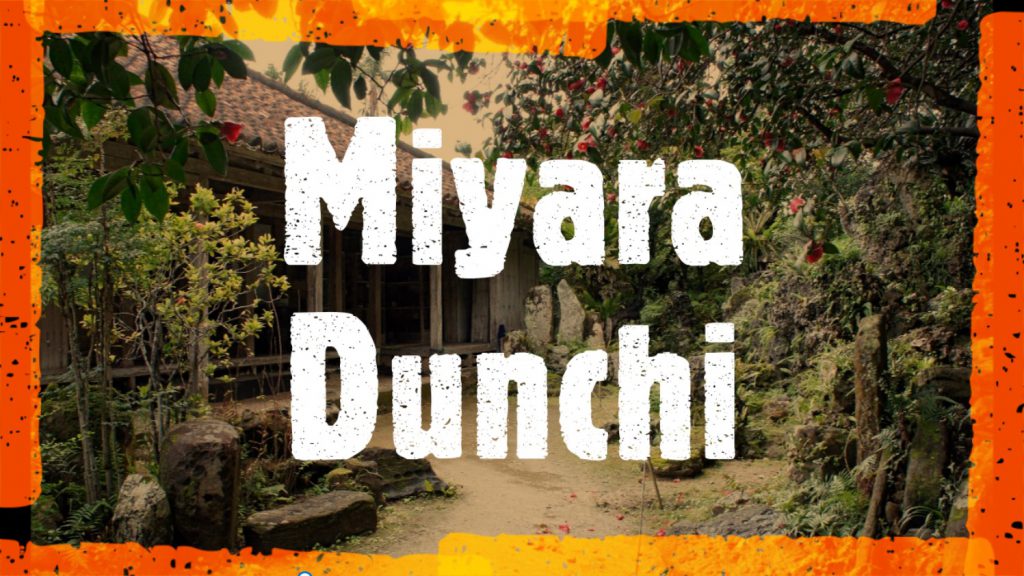(from Japanese Wikipedia, translation by Andreas Quast)
Tunchi is a honorary title referring to the Uēkata families from among the Ryūkyū samurē class (shizoku) who are in the position of a sōjitō (estate steward-general). In a broader sense, it is also used for the households of assistant estate stewards (waki-jitō). The Tunchi are families of high social standing positioned below the royal Udun families. Together with the Udun, their social class is summarized in the umbrella term Udun Tunchi, and it is also called daimyō-gata.
Overview
Just as in the case of the Udun, the term Tunchi originally referred to the family residences, here those of Uēkata families. From there, the Uēkata families came to be called “so-and-so Dunchi.” In that case, the first voiced consonant becomes soften and it is pronounced Dunchi. For example, it is like in Oroku Dunchi. In addition, outside of Shuri, it was also pronounced Tonuchi.
The designation Tunchi was also used by Uēkata families who served as waki-jitō (assistant estate steward), but in that case they were not called daimyō-gata. In addition, while Pēkumī houses, which were positioned below the Uēkata, did not actually own a territory, they also held the post of a waki-jitō (assistant estate steward), and so certain medium-level samurē houses were also sometimes called Tunchi. Others, such as in case of the Shuri Dunchi (shrine of three districts of Shuri) or the local Noro Dunchi, the word was also used in the designations of shrines of formal religious institutions. In addition, local distinguished families (not necessarily shizoku) were sometimes referred to by these names, such as Miyara Dunchi, who was the headman (gashira) of Yaeyama, or Mekaru Udun, who was the fujitō (assistant local estate steward) of Izena Island.
Housholds of sō-jitō (estate steward-generals)
Kunigami region
- Ōgimi Dunchi of the Princely Shō-clan (Ōgimi Magiri)
- Ikegusuku Dunchi of the Mō-clan (Haneji Magiri)
- Fukuyama Dunchi of the Princely Shō-clan (Nakijin Magiri)
- Inoha Dunchi of the Mō-clan (Motobu Magiri)
- Nago Dunchi of the Tei-clan (Nago Magiri)
- Nakada Dunchi of the Princely Shō-clan (Kushi Magiri)
- Uema Dunchi of the Ba-clan (Kin Magiri)
- Sadoyama Dunchi of the Mō-clan (Onna Magiri)
- Ie Dunchi of the Princely Shō-clan (Ie island)
Nakagami region
- Gushikawa Dunchi of the Princely Shō-clan (Gushikawa Magiri)
- Misato Dunchi of the Mō-clan (Misato Magiri)
- Kamegawa Dunchi of the Mō-clan (Yonagusuku Magiri)
- Katsuren Dunchi of the Mō-clan (Katsuren Magiri)
- Wakugawa Dunchi of the Princely Shō-clan (Goeku Magiri)
- Ishadō Dunchi of the Ō-clan (Nakagusuku Magiri)
- Zakimi Dunchi of the Mō-clan (Yuntanza Magiri)
- Sakuma Dunchi of the Shō-clan (Chatan Magiri)
- Giwan Dunchi of the Princely Shō-clan (Ginowan Magiri)
- Urasoe Dunchi of the Princely Shō-clan (Urasoe Magiri)
- Kōchi Dunchi of the Princely Shō-clan (Nishihara Magiri)
Shimajiri region
- Shikina Dunchi of the Princely Shō-clan (Mawashi Magiri)
- Oroku Dunchi of the Ba-clan (Oroku Magiri)
- Tomigusuku Dunchi of the Mō-clan (Tomigusuku Magiri)
- Kanegusuku Dunchi of the Princely Shō-clan (Kanegusuku Magiri)
- Fukumura Dunchi of the Mō-clan (Takamine Magiri)
- Makabe Dunchi of the Princely Shō-clan (Makabe Magiri)
- Kyan Dunchi of the Princely Shō-clan (Kyan Magiri)
- Mabuni Dunchi of the Ka-clan (Mabuni Magiri)
- Kochinda Dunchi of the Mō-clan (Kochinda Magiri)
- Gushichan Dunchi of the Sai-clan (Gushichan Magiri)
- Tamagusuku Pēkumī (Tamagusuku Magiri)
- Miyahira Dunchi of the Ba-clan (Haebaru Magiri)
- Yonabaru Dunchi of the Ba-clan (Ōsato Magiri)
- Moriyama Dunchi of the Princely Shō-clan (Sashiki Magiri)
- Chinen Satonushi (Chinen Magiri)
- Izena Dunchi of the Princely Shō-clan (Izena Island and Izena Island)
- Nishihira Dunchi of the Mō-clan (Kume Gushikawa Magiri)
- Tomigawa Dunchi of the Mō-clan (Kume Nakazato Magiri)
(Created from: Ryūkyū Hanshin Karoku-ki, 1873. Bold text shows the head houses (honke, excluding the Princely Shō-clan).
Housholds of waki-jitō (assistant estate stewards)
- Maegawa Dunchi of the A-clan (Tamagusuku Magiri Maegawa village)
- Nagayama Dunchi of the Ō-clan (Nakagusuku Magiri Tsuha village)
- Yonaha Dunchi of the Go-clan (Tomigusuku Magiri Yonaha village)
- Gima Dunchi of the Sai-clan(Oroku Magiri Gima village)
- Ō Dunchi of the Princely Shō-clan (Tamagusuku Magiri Ō village)
- Kamida Dunchi of the Princely Shō-clan(Mawashi Magiri Makabi village)
- Hentona Dunchi of the Princely Shō-clan(Kunigami Magiri Hentona village)
- Kogusuku Dunchi of the Tei-clan(Oroku Magiri Kogusuku village)
- Tsuhako Dunchi of the Tō-clan (Sashiki Magiri Tsuhako village)
Bold text shows the head houses (honke, excluding the Princely Shō-clan).
Bibliographical references
- Okinawa Daihyakka Jiten Kankō Jimukyoku-hen: Okinawa Daihyakka Jiten (Large Encyclopedia of Okinawa, 1983). Okinawa Taimusu-sha, 1983.
- Miyazato Chōkō (ed.): Okinawa Monchū Daijiten (Large Dictionary of Paternal Kinship Groups of Okinawa). Naha Shuppan-sha, 1998. ISBN 978-4890951017.
Related items
- Uēkata (Okinawa)
- Udun (Okinawa)
- Ryūkyū court ranks
- List of the Ryūkyū Estate stewards (jitō)
Translator’s note
Tunchi is the title of the residence of an estate steward (jitō). In other words, the term refers to the residences of the class of regional administrators on district and village level. The organization of regional administration extended throughout the Ryūkyū Kingdom, as can be seen in the Miyara Dunchi of Ishigaki Island, Yaeyama. The architecture of Miyara Dunchi mimics the shizoku (samurē class) mansions of Shuri. It was built around 1819, when Miyara Tō’en, the eighth head of the Miyara family, held the post of the estate steward (jitō) of Miyara district.

© 2020, Andreas Quast. All rights reserved.
